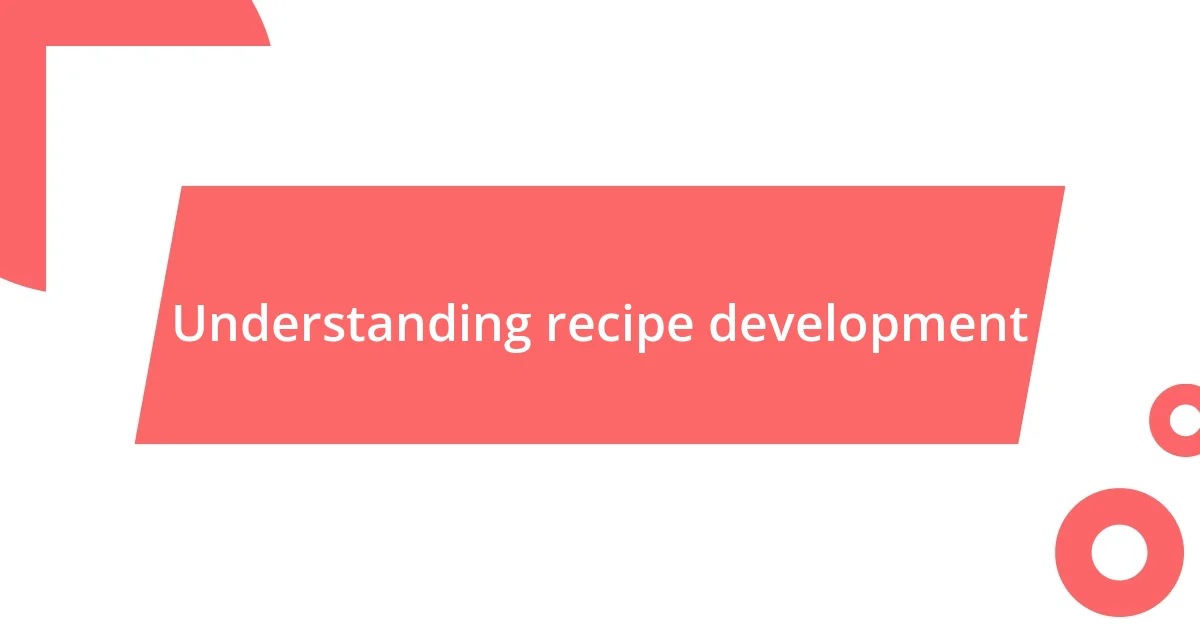Key takeaways:
- Recipe development blends creativity and science, emphasizing the importance of understanding ingredient interactions and embracing trial and error.
- Identifying flavor combinations involves principles like contrast, harmony, seasonality, and personal preferences, leading to joyful culinary discoveries.
- Gathering feedback from testers and focusing on presentation are essential for refining recipes and enhancing the overall dining experience.

Understanding recipe development
Recipe development is truly an art form, blending science with creativity. I remember the first time I experimented with a classic dish, trying to add my twist to it. The excitement of balancing flavors and textures felt exhilarating, but it also came with that underlying fear of whether my changes would work or fall flat.
As I navigated through various trials, I realized the importance of understanding ingredients. Each has its personality—the sweetness of fresh basil, the tanginess of a good vinegar— and knowing how they interact can turn a simple dish into something memorable. Have you ever had a moment when you tasted something unexpected and thought, “Wow, how did they do that?” That’s the magic of combining the right elements in the right way, and it often takes a few attempts to get there.
It’s also essential to embrace the process of trial and error. There are times when a recipe completely tanked, and I had to question what went wrong. Did I use too much salt? Was the cooking time off? Every misstep has taught me valuable lessons, reinforcing the idea that each failure is a stepping stone to creating something truly amazing.

Identifying flavor combinations
Identifying flavor combinations is a fascinating endeavor that can transform the way we think about food. When I first began exploring this aspect of recipe creation, I often relied on instinct and a bit of tradition. The thrill of pairing sweet and savory in unexpected ways, like blending honey with balsamic vinegar, opened up a world of possibilities for my dishes. Each combination felt like an adventure, especially when I discovered how the crispness of fresh cilantro could elevate the richness of avocado.
To streamline the process, I focus on a few key principles when identifying flavor pairings:
- Contrast: Balancing rich flavors with acidic or spicy counterparts, like creamy cheese with tangy fruit.
- Harmony: Sharing earthy qualities, such as the deep flavors of roasted garlic and savory herbs.
- Regional Influences: Exploring the traditional combinations found in various cuisines, like Mediterranean ingredients with their bright, fresh herbs.
- Seasonality: Considering what ingredients are at their peak, like pairing juicy summer tomatoes with fragrant basil.
- Personal Preferences: Reflecting on my own taste experiences, like my love for chocolate with a hint of sea salt, allows me to create connections that resonate with me.
Every time I experiment, I relish the joy of discovering something new. If something doesn’t work out, I take note, recalibrating and experimenting again, knowing that the process is just as important as the end result.

Selecting ingredients wisely
Selecting the right ingredients is crucial in my recipe development journey. I pay close attention not just to what’s available, but also to the quality and the story behind each ingredient. For instance, when I visit farmers’ markets, I’m often inspired by the vibrant produce and the conversations with local growers. Their passion for their ingredients adds a layer of meaning to my cooking, reminding me that food is so much more than just sustenance.
I also find that choosing seasonal ingredients not only enhances flavor but also brings an element of freshness to my dishes. I remember a summer when I sourced heirloom tomatoes directly from a local farm. Their rich, sun-ripened taste made all the difference in a simple salad, imbuing it with nostalgia and joy. Have you ever tasted a tomato that was just bursting with flavor? It’s in those moments that I feel the connection between the earth and our plates, which elevates even the simplest meals.
I like to create a mental checklist for selecting ingredients wisely, balancing between culinary goals and resource availability. Quality versus quantity often comes into play; sometimes, fewer high-quality ingredients can create a more profound impact than many mediocre ones. This strategic decision-making is what ultimately leads to memorable meals—the kind you savor and share with others.
| Ingredient Type | Impact on Dish |
|---|---|
| Fresh | Enhances flavor and texture |
| Seasonal | Brings out vivid flavors |
| Local | Supports community and sustainability |
| Quality over Quantity | Creates depth in flavor |

Testing and adjusting recipes
Testing a recipe can feel like a cinematic experience—I often find myself in the role of both director and actor. After crafting a new dish, I let it sit for a moment, allowing the flavors to breathe and settle. Then, with the first bite, I’m instantly transported back to the kitchen, analyzing everything from texture to seasoning. It’s a deeply personal moment; I ask myself, “Does this make my taste buds dance?” If not, I note what needs adjusting, whether that’s a pinch more salt or a splash of acid to brighten the dish.
Once I’ve tasted the initial creation, I like to invite friends and family over for a test run. It may seem daunting, but sharing my culinary experiments fuels my passion. Their reactions—enthusiastic cheers or thoughtful murmurs—act as a guiding compass. Recently, I tested a spicy roasted carrot dish and found that adding a touch of maple syrup stirred joy, balancing the heat with sweetness. Feedback isn’t just helpful; it’s also a chance to connect, relishing shared experiences over good food.
Yet, I’ve learned that testing really is a cycle of trial and error. Sometimes, even after several tweaks, a dish might still fall flat. I remember crafting a chocolate cake that, despite my efforts, was too dense. Instead of feeling defeated, I embraced the challenge and adjusted the ingredients, ultimately transforming it into a light, airy treat. This process taught me that every failure is simply a stepping stone towards success—a key lesson that enriches my journey in the kitchen. Isn’t it enriching to know that every effort brings us closer to mastery?

Documenting the recipe process
Documenting the recipe process is an essential part of my culinary journey. I often find that jotting down each stage—whether it’s the ingredients used or the cooking techniques applied—helps me capture the essence of what makes a dish special. I remember one time when I developed a fragrant lemon herb chicken; I noted not just the ingredients but the exact timing for marinating. Later, that meticulous detail became key when I wanted to recreate that flavorful success.
When documenting, I pay careful attention to the sensory experiences. I might write down how the garlic sizzles when it hits the oil, or the vibrant colors of fresh herbs stirring together in the bowl. This sensory diary not only serves as a reference for future cooking but also brings back memories tied to those smells and flavors. Have you noticed how aromas can transport you back to a cherished moment? Capturing these nuances elevates my recipes from mere instructions to heartfelt stories.
I also utilize a digital platform to store my recipes, allowing me to track adjustments and successes over time. It’s incredibly satisfying to look back at where I started—like that time I made a risotto that just wouldn’t come together, but I learned so much from the experience. Each documented detail provides a stepping stone, creating a richer understanding of the cooking process. I invite you to consider: how does your approach to documenting recipes enhance your culinary adventures?

Engaging feedback from testers
Gathering feedback from my testers is like opening a window to a wider perspective. During one of my recent recipe trials, a close friend commented that the dish felt too rich, which led me to rethink the balance of ingredients. I appreciated their honesty because it’s easy to become so immersed in my own flavors that I overlook how they resonate with others. Have you ever experienced that moment when someone points out something you missed? It’s illuminating!
I also create a safe space for feedback by encouraging testers to share their true thoughts, whether it’s praise or constructive criticism. After introducing a new herb in a pasta dish, one friend mentioned it was overpowering, which initially stung. But instead of dismissing her input, I chose to experiment with different herb ratios. This collaboration not only refined the recipe but also deepened our connection over shared culinary exploration.
Incorporating diverse perspectives enhances my culinary creations. Once, after serving a caramelized onion tart, I received feedback that it could use some acidity. I was surprised at how a simple squeeze of lemon transformed the flavors, making them pop! It reminded me that collaborating with others, even if it feels vulnerable, is vital in the recipe development process. How do you handle feedback when creating your dishes? Embracing those insights often leads to delightful surprises in the kitchen.

Finalizing and presenting recipes
Finalizing a recipe is about more than just listing ingredients and methods; it’s the moment of transformation. After I tweak a dish, I like to revisit it with a fresh palate. I remember a time when I perfected a spicy mango salsa. The first iteration was tasty, but the final version truly sang after I added a hint of lime and let the flavors meld overnight. How often do you revisit a dish to discover new dimensions?
Presenting a recipe to others is an art that can be just as important as the cooking itself. I always try to incorporate beautiful plating when sharing my creations. It could be as simple as vibrant garnishes or elegant serving dishes. I vividly recall presenting a chocolate tart at a gathering, topped with fresh berries and mint. The “ooohs” and “aaahs” that followed made me realize how much presentation impacts our enjoyment of food. Have you ever been taken by a dish because of how it looked?
Photography plays a crucial role in this final step for me. Capturing the essence of a dish through images is like preserving a moment in time. I remember snapping photos of a bright, colorful summer salad on a sunny afternoon, the natural light highlighting the fresh ingredients. Those images help convey the story of the recipe and inspire others to try their hand at it. What do you find most rewarding about sharing your culinary creations visually?















